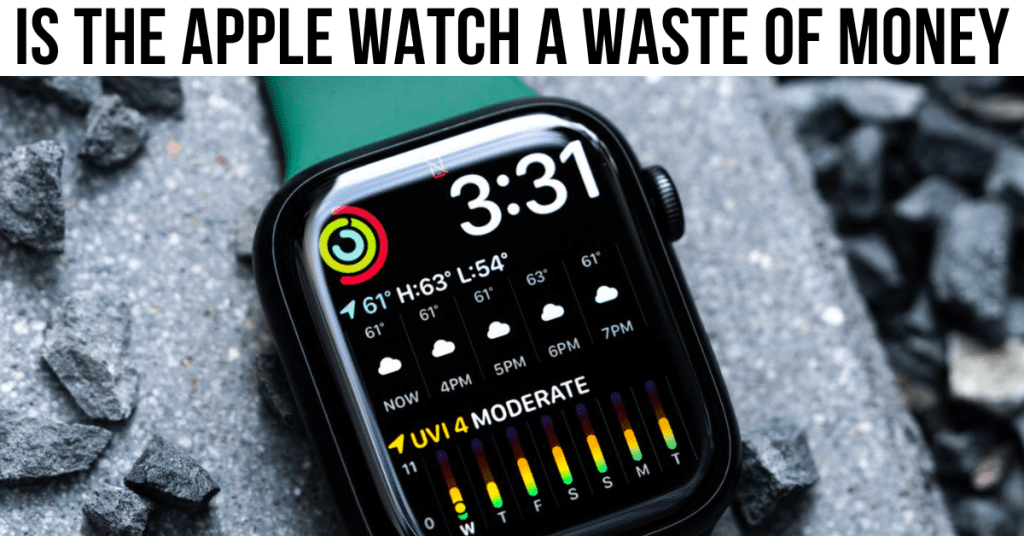Apple has become synonymous with innovation and cutting-edge design. One of their most popular devices, the Apple Watch, has captured the attention of consumers worldwide. However, beneath its sleek exterior and promising features lies a gadget that fails to live up to its hype. In this article, we will delve into the reasons Why The Apple Watch is a Waste of Money.
Reasons Why the Apple Watch is Nothing More Than a Wasteful Investment
Limited Functionality and a Wasteful Investment
The Apple Watch, a sleek and highly marketed smartwatch, has garnered attention from tech enthusiasts and Apple fans alike. However, beneath its trendy exterior lies a device that falls short in delivering the functionality it promises.
Redundancy of Features:
One of the primary reasons the Apple Watch fails to justify its price is the redundancy of its features. Basic functions like receiving notifications, checking the time, and tracking fitness activities are already seamlessly integrated into our smartphones. Carrying an additional device solely for these purposes seems impractical and unnecessary. The Apple Watch essentially duplicates the functionality of a smartphone, making it an extravagant accessory rather than an indispensable gadget.
Restricted Screen Real Estate:
Another drawback of the Apple Watch is its small screen size, which limits its usability. The compact display makes it challenging to navigate apps, read text, or view detailed content effectively. This constraint becomes even more pronounced when using third-party apps that are not optimized for the watch’s limited screen real estate. Tasks that are simple and effortless on a smartphone can become cumbersome and frustrating on the Apple Watch, diminishing the overall user experience.
Limited App Ecosystem:
While the Apple Watch boasts an extensive app ecosystem, the reality is that most apps are underwhelming and fail to offer significant value. Developers often struggle to create compelling and fully functional apps for such a small device. Consequently, the available apps tend to be basic and provide a diluted experience compared to their smartphone counterparts. The limited app selection greatly restricts the potential of the Apple Watch, further diminishing its overall functionality.
Dependence on iPhone:
To fully unlock the capabilities of the Apple Watch, one must own an iPhone. Without an iPhone, the watch’s functionality is significantly limited. This dependency restricts the Apple Watch’s appeal and alienates potential users who prefer different smartphone brands or those who do not want to invest in an additional Apple device. The inability to use the watch independently reduces its value and makes it an impractical choice for a wide range of consumers.
Overemphasis on Fitness Tracking and a Questionable Investment
The Apple Watch has gained popularity as a comprehensive smartwatch, marketed as an all-in-one device for various functionalities. However, its overemphasis on fitness tracking as a selling point raises questions about its true value.
Availability of Alternative Fitness Trackers:
While the Apple Watch offers a range of fitness tracking features, it is not the only device capable of providing such functionalities. In fact, there is a plethora of dedicated fitness trackers available in the market that offer similar features at lower price points. These alternatives often provide accurate step tracking, heart rate monitoring, and calorie counting, rendering the Apple Watch’s fitness tracking capabilities redundant. Investing in a dedicated fitness tracker can be a more cost-effective option for those primarily interested in fitness monitoring.
Inaccuracies and Reliability Concerns:
Despite its claims of accurate fitness tracking, the Apple Watch is not immune to discrepancies and reliability concerns. Studies and user experiences have highlighted inconsistencies in heart rate monitoring and step counting, raising doubts about the reliability of the data provided. For individuals who heavily rely on accurate fitness metrics for training or health purposes, these inaccuracies can undermine the usefulness of the Apple Watch as a fitness companion.
Neglecting Other Smartwatch Features:
By placing excessive emphasis on fitness tracking, the Apple Watch neglects other smartwatch features that could enhance its overall value. While fitness tracking is undoubtedly important for many users, it is just one aspect of a smartwatch’s potential. By devoting substantial resources to fitness features, the Apple Watch sacrifices advancements in other areas, such as productivity, communication, and entertainment. As a result, users are left with a device that excels in fitness tracking but falls short in delivering a well-rounded smartwatch experience.
Personal Preferences and Varied Interests:
Not all individuals prioritize fitness tracking as the main reason for purchasing a smartwatch. People have diverse interests and requirements, ranging from productivity and communication to fashion and style. For those who do not place fitness tracking at the forefront of their needs, the Apple Watch’s overemphasis on this aspect diminishes its overall appeal and may lead to the conclusion that it is an unnecessary and costly investment.
Limited Battery Life and a Costly Trade-Off
One of the biggest drawbacks of the Apple Watch is its limited battery life. On average, it lasts only around 18 hours before requiring a recharge. This means users must remember to charge it daily, which can be a hassle, especially for those who lead busy lives. Comparatively, traditional wristwatches can last for years on a single battery replacement. The Apple Watch’s short battery life diminishes its convenience and adds an unnecessary burden to the user’s routine.
Daily Charging Hassles:
Unlike traditional wrist watches that can last for years on a single battery replacement, the Apple Watch requires daily charging. This constant need for recharging adds an extra step to users’ routines, becoming an inconvenience for individuals with busy lifestyles. Forgetting to charge the watch overnight can lead to it being unusable throughout the day, negating the convenience that a wristwatch should offer.
Dependency on Charging Infrastructure:
The Apple Watch’s limited battery life also means users must have access to charging infrastructure throughout the day. This requirement becomes especially burdensome during travel or outdoor activities when access to power outlets may be limited. Users must carry chargers or power banks with them, further complicating the watch’s portability and diminishing its practicality as a reliable companion for extended periods.
Incompatibility with Sleep Tracking:
Given the need for daily charging, using the Apple Watch for sleep tracking becomes impractical. Sleep tracking is a valuable feature for monitoring sleep patterns and improving overall well-being. However, with the Apple Watch requiring charging overnight, users have to sacrifice sleep tracking functionality or find alternative methods to track their sleep patterns. This limitation diminishes the watch’s appeal as a comprehensive health and fitness device.
Battery Degradation Over Time:
Battery degradation is an inevitable reality for any device with a rechargeable battery, including the Apple Watch. Over time, the watch’s battery capacity diminishes, leading to shorter battery life and more frequent charging requirements. This degradation can be frustrating for users who initially enjoyed a full day’s use without recharging but eventually find themselves needing to charge the watch multiple times a day. As the battery deteriorates, the overall value and usability of the Apple Watch diminishes, making it a questionable long-term investment.
Expensive Repairs and Accessories, A Costly Gamble
The Apple Watch, known for its sleek design and advanced features, comes with a price tag that matches its premium reputation. However, the hidden costs associated with expensive repairs and accessories often make it a wasteful investment.
High Repair Costs:
Apple products, including the Apple Watch, are notorious for their expensive repairs. If the screen cracks or any other hardware issue arises, the cost of repair can be exorbitant, often approaching or even exceeding the price of a new watch. This hefty repair price tag makes accidental damage or hardware issues a costly burden for Apple Watch owners. Investing in a device that requires such expensive repairs can quickly turn into a regrettable financial decision.
Limited Repair Options:
Repairing an Apple Watch is not as simple as taking it to a local repair shop. Apple tightly controls the repair process and restricts access to authorized service centers. This limitation forces users to rely solely on Apple for repairs, which can result in longer wait times and limited availability of service centers in certain regions. The lack of options leaves consumers at the mercy of Apple’s repair infrastructure, further adding to the inconvenience and potential costs.
Premium-Priced Accessories:
In addition to expensive repairs, the accessories specifically designed for the Apple Watch come with premium price tags. Apple offers a range of bands, cases, and chargers, all sold at a premium compared to third-party alternatives. This means that personalizing and enhancing the Apple Watch experience comes with an added cost. Investing in accessories can quickly inflate the overall expense of owning an Apple Watch, making it a costly endeavor for those seeking customization or style.
Limited Compatibility:
Apple’s tight control extends to accessory compatibility as well. While there are third-party options available, Apple’s proprietary system limits the choices for users. The compatibility restrictions mean that users often have to purchase accessories directly from Apple or authorized retailers, further contributing to the overall cost. This lack of compatibility with a broader range of accessories reduces options and forces users to pay a premium for Apple-branded products.
Reliance on Other Apple Devices and a Limited Appeal
The Apple Watch, a popular smartwatch from Apple, has garnered attention for its sleek design and impressive features. However, its heavy reliance on other Apple devices limits its appeal and raises questions about its value as a standalone investment.
Exclusive Compatibility with iPhones:
The Apple Watch is primarily designed to work in tandem with iPhones, creating a seamless ecosystem. While this integration enhances certain features, it also excludes users who do not own an iPhone. Non-iPhone users or individuals who switch to a different smartphone brand in the future find themselves unable to fully utilize the Apple Watch’s capabilities. This exclusivity restricts the potential user base and makes the watch an impractical choice for a significant portion of consumers.
Limited Functionality with Non-Apple Devices:
Even if the Apple Watch can be paired with non-Apple smartphones, its functionality is severely limited. Non-Apple devices lack the deep integration and compatibility necessary to unlock the full potential of the watch. Many advanced features, such as seamless syncing, messaging, and app performance, are optimized for Apple devices. As a result, users of non-Apple devices are left with a diminished experience and a smartwatch that fails to deliver on its promised functionalities.
Incompatibility with Third-Party Apps:
The Apple Watch’s reliance on other Apple devices extends to third-party apps as well. While there is an app ecosystem available for the watch, the functionality and performance of these apps are often limited compared to their iPhone counterparts. Developers face challenges in creating robust and feature-rich apps for the small screen and limited processing power of the watch. Consequently, users may find that the apps they rely on or enjoy using on their iPhones do not provide the same level of functionality or convenience on the Apple Watch.
Vendor Lock-in and Upgrading Costs:
By investing in an Apple Watch, users commit to the Apple ecosystem, which can result in vendor lock-in. As the Apple Watch relies on other Apple devices, users may feel compelled to upgrade their iPhones regularly to maintain compatibility and take advantage of the latest features. This constant need for device upgrades incurs additional costs and can be financially burdensome. The continuous cycle of upgrading devices to support the Apple Watch further highlights its wastefulness as an independent investment.
Conclusion
While the Apple Watch has gained popularity and a dedicated following, it ultimately falls short in delivering value for the price. With limited functionality, overemphasis on fitness tracking, short battery life, expensive repairs and accessories, and reliance on other Apple devices, the Apple Watch can be seen as nothing more than a wasteful expenditure. Consumers seeking a practical and cost-effective smartwatch alternative should explore the numerous options available on the market today.
Michael C Vang is a passionate blogger. He has been blogging since 2013 on a variety of topics. He is committed to creating informative and engaging content that helps readers learn more about everything.



